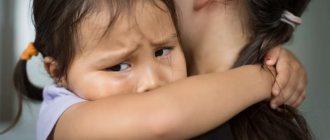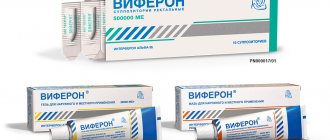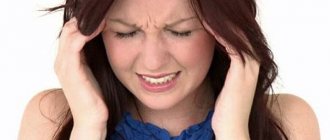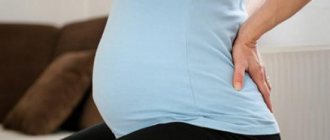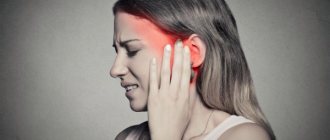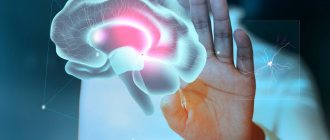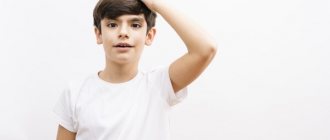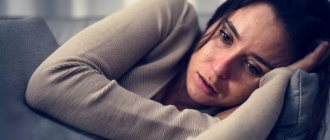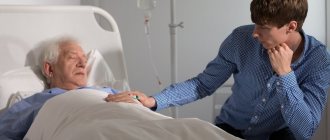This is a group of slowly progressive and non-progressive clinically and genetically heterogeneous diseases that are inherited predominantly in an autosomal recessive manner. Congenital muscular dystrophies (CMD) appear at birth or in the first 12 months of life. They are accompanied by hypotension and progressive muscle weakness, delayed motor development. Often against the background of AMD, contractures and disorders of the visual organs and central nervous system develop.
Causes and forms of congenital muscular dystrophies
Data on the molecular genetic basis of AMD have made it possible to compile a classification of pathologies. Based on the genetic and biochemical defect, the following groups of congenital muscular dystrophies are distinguished:
- caused by defects in structural proteins (Ullrich congenital muscular dystrophy, Bethlem, merosin-deficient form, integrin-deficient form, with epidermolysis bullosa, with joint hypermobility);
- associated with glycosylation defects (Walker-Warburg syndrome, cerebroocular muscular dystrophy, Fukuyama AMD, congenital muscular dystrophies with muscle hypertrophy, with abnormal glycosylation of alpha-dystroglycan and severe mental retardation, with pseudohypertrophy, macroglossia and respiratory failure);
- caused by defects in the proteins of the endoplasmic reticulum and nucleus (rigid spine syndrome, LMNA-deficient congenital muscular dystrophy);
- other forms (AMD with impaired mitochondrial structure, etc.).
General information
A characteristic feature of the disease is metabolic disorders in skeletal muscle tissue. The muscles of a sick child lose their function partially or entirely, that is, weakness appears in them and the range of movements decreases. The quality of life is significantly reduced. Source: Komantsev V.N., Skripchenko N.V., Sosina E.S., Klimkin A.V. POLYNEUROPATHY AND MYOPATHY OF CRITICAL CONDITIONS IN ADULTS AND CHILDREN: DIAGNOSIS, CLINICAL MANIFESTATIONS, PROGNOSIS, TREATMENT // Modern problems of science and education. – 2012. – No. 5
This pathology usually has a hereditary form and can be diagnosed in children of any age. It is not life-threatening, except in cases where atrophy of the heart muscle and respiratory muscles occurs. Source: https://www.ncbi.nlm.nih.gov/pmc/articles/PMC2796972/ Chris M. Jay, Nick Levonyak, Gregory Nemunaitis, Phillip B. Maples and John Nemunaitis Hereditary Inclusion Body Myopathy (HIBM2) Gene Regul Syst Bio. 2009; 3: 181–190.
The disease has a number of complications:
- development of respiratory failure;
- limited mobility;
- paralysis;
- congestive pneumonia;
- depressive, suicidal mood of the patient;
- increased risk of death.
Medical rehabilitation of children suffering from muscular dystrophy
Rehabilitation for muscular dystrophy - goals and objectives
Progressive muscular dystrophies are a group of diseases whose common symptoms are weakness, skeletal muscle atrophy, dysfunction of support and movement, and contractures. 45-60% of muscular dystrophies are hereditary. Rehabilitation for muscular dystrophy goes hand in hand with treatment. Let's look at the basics and main directions.
The main goal of rehabilitation of children with muscular dystrophy is, possibly, early detection and treatment, compensation for impaired functions of the musculoskeletal system, the maximum possible preservation of motor functions, and preparing the child for life in society.
When drawing up a rehabilitation program, the main direction is functional. The goal is to maximally develop or at least somehow preserve the child’s motor abilities. Doctors of different specialties and all necessary profiles participate in the preparation of the program. The form, stage of the disease, and the mechanism of motor dysfunction are taken into account.
Rehabilitation measures begin from the first days and, given the severity of the condition, can be carried out for the rest of your life. Medical rehabilitation is inextricably linked with pedagogy and psychology, and in relation not only to the child, but also to adult family members.
Stages of rehabilitation for progressive muscular dystrophy
- The first stage of rehabilitation for PMD begins in the hospital, after a complete examination of the child. In fact, at this stage, restorative treatment is carried out to help stabilize the process. Its duration can last up to 30-35 days, depending on the stage of the disease, rate and progression. At this stage, a large number of procedures are performed to stimulate muscle activity - myostimulation, hydrokinesitherapy, parenteral administration of drugs).
- The second stage is the sanatorium-resort stage, carried out in a local sanatorium or at a nearby resort. The objectives of this stage are to maintain and develop the achieved effect using natural physical factors. This is physiotherapy combined with climatic therapy, mud therapy, and physical therapy.
- The third stage of rehabilitation is outpatient treatment. At this stage, all possible activities and physical procedures are carried out at home. In a clinic setting, you can conduct a course of physiotherapy, massage and exercise therapy 2-3 times a year.
The goal of rehabilitation is not only the need to provide medical care, but also to help educate, become socially independent, and acquire a profession.
Differentiated rehabilitation complex for PMD
The rehabilitation program complex is developed depending on the form, stage of the disease, and the age of the child. The complex may include medications, orthopedic, physiotherapeutic methods, massage and physical therapy. The motor mode is important for patients with PMD. It is necessary to maintain all available movements, since hypokinesia leads to the progression of atrophy and contractures.
Diet and medication are also equally important. When choosing a diet, the main task is the need to compensate for protein deficiency. The protein content in food is increased to 110 - 140 g at a norm of 105 in the form of cottage cheese, fish, boiled meat. Drug treatment for this disease is carried out constantly, almost throughout life. The main drugs for PMD are anabolic steroids, prescribed to reduce the breakdown of muscle proteins, as well as amino acids, which are taken to replenish protein lost by the body.
Physiotherapy
In previous years, exercise therapy for myopathies was considered contraindicated. However, clinical studies have shown that dosed and targeted physical activity, which does not increase the breakdown of muscle tissue, is a metabolic stimulator necessary for the proper development of children. Also, physical activity is the prevention of contractures and deformations of bone tissue. Types of exercise therapy and the pace of classes are selected individually.
The main types of physical activity that are prescribed to patients with PMD:
- morning exercises
- physiotherapy
- walks and games
- hydrokinesitherapy
Morning exercises are carried out 8-10 minutes before breakfast, at a slow pace, periodically changing the set of physical exercises. You can conduct classes in a playful way.
Therapeutic gymnastics includes general strengthening and gentle exercises to train affected muscles and maintain range of motion. Be sure to include breathing exercises that promote deep inhalation and forceful exhalation. Various assistive devices can be used. The duration of therapeutic exercises ranges from 15 to 30 minutes, depending on the child’s condition.
Hydrokinesitherapy - physical exercise in water and pool is the preferred type of physical activity for children suffering from muscular dystrophy. Exercises in warm water promote muscle relaxation, improve blood circulation, affect weakened muscles and help restore range of motion. The water environment facilitates static load, helps maintain an upright posture, strengthen supporting function, and stimulate walking.
Classes in the pool are held 2 - 3 times a week. Beforehand, you can do a short warm-up in the hall. The lesson consists of 5-7 minutes of free swimming, then 10 minutes of exercises with the participation of a trainer, underwater massage and free swimming.
Therapeutic swimming in the pool is carried out at a water temperature of 29 - 30 degrees. Recommended for children with mild damage and slow progression of the disease.
Massage for PMD
Massage is also actively prescribed and used for various forms of muscular dystrophy. In the primary form, a light, superficial massage of the affected muscles and general massage, using stroking and rubbing techniques, are prescribed. Massage causes a reaction in the neurovascular system, increases blood and lymph circulation, oxygen saturation and tissue nutrition.
First of all, massage the back and limbs (10-15 minutes, up to 30 procedures per course, up to 5 courses throughout the year). Massage can be performed at home by parents who have been trained by specialists.
Underwater manual massage in warm water for joint contractures enhances relaxation and blood circulation. Use stroking and light kneading techniques.
Massage is often combined with other physical therapy methods. When developing contractures, a thermal procedure is first recommended, then massage. After the massage, if necessary, an electrotherapy procedure (Electrophoresis or SMT) is prescribed. It is very important to skillfully select massage techniques with strictly individual dosage.
Natural physical factors in the treatment of muscular dystrophy
Physical factors are also widely prescribed for progressive muscular dystrophy. They have a general strengthening effect, improve metabolic processes, blood supply, trophism of muscles and tissues. Let's consider the most commonly recommended natural physical factors for PMD:
- Aerotherapy and climate therapy. The basis of the therapeutic effect is the child’s stay in the fresh air. Air baths are carried out in combination with light physical exercise. Walking and light games in the air help reduce hypoxia and harden.
- Preventive ultraviolet irradiation - indicated in autumn and winter. Irradiation is carried out individually, using UV radiation sources. The stimulating effect of UV radiation is aimed at the synthesis of vitamin D, which is involved in the processes of mineral metabolism and ossification.
- Water and heat therapy. For PMD, local baths, sodium chloride, hydrogen sulfide, radon baths, as well as mud therapy are actively used.
- Paraffin-ozokerite applications are recommended for joint contractures and impaired motor functions. Heat therapy improves blood supply to muscles and increases their elasticity. Ozokerite temperature is 42 - 43 degrees, duration is 12 - 20 minutes, up to 10 procedures per day.
- Mud applications are carried out on the segmental reflex zone at a mud temperature of 38 degrees. Under the influence of mud applications, blood supply to the extremities improves and the temperature of the skin on the hands and feet increases.
Hardware physiotherapy
Among hardware treatment methods, priority is given to electrotherapy methods. The reason is clear, because the main need for PMD is stimulation of muscle activity. But at the same time, when prescribing electrotherapy methods, you must be extremely careful and carefully monitor the condition of the muscles and their response to the electrical stimulus.
Electrical stimulation is predominantly carried out using the SMT technique. The muscles most important for statics are exposed. The current strength is selected individually, taking into account the above factor of alertness. The current strength is chosen to be minimal, sufficient to cause a response muscle contraction. The procedure lasts 1 - 2 minutes, then alternates with 2 - 3 minutes of rest.
To administer medications, the drug electrophoresis procedure is actively prescribed. The most commonly used are medicinal electrophoresis using the ion reflex technique, endonasal vitamin B electrophoresis, and proserine electrophoresis.
- Drug electrophoresis using the ion reflex method improves autonomic regulation.
- Endonasal vitamin B electrophoresis is used from 3 to 5 years of age and promotes accelerated absorption of vitamin B through the nasal mucous membranes.
- Electrophoresis of proserin is carried out according to the method of general influence, and can be combined with a course of diadynamic therapy.
The use of electrophoresis on the area of affected muscles is contraindicated in the presence of contractures, in severe motor disorders, as well as in intolerance to prescribed drugs.
Physical therapy methods are used in the very initial stages of the disease, as soon as the diagnosis is established. Its effectiveness is greater with light and moderate severity. Physiotherapy is prescribed in combination with physical therapy, massage, medications, and orthopedic measures.
Orthopedic measures for PMD
Orthopedic measures are aimed at preventing and correcting deformities, maintaining motor activity and mobility of the limbs. Prevention and conservative correction of contractures are carried out using muscle bandages and splints. At different stages of the disease, orthopedic placement and seating of the patient with fixing bandages can prevent the development of deformities. In the process of rehabilitation of patients with PMD, special prosthetic and orthopedic devices are used that fix the muscles of the limbs, which helps maintain the ability to support oneself.
In case of neural amyotrophy, special shoes are made for the sick child to fix the foot. Maintaining the ability to support the limbs is important for physical and mental development.
In addition to the above medical techniques, children are also actively given psychological rehabilitation. This includes occupational therapy, which in childhood is carried out in the form of a game. During the engagement process, the child is taught basic self-care skills. Music therapy is also carried out in various forms and whenever possible, because it is not always possible to conduct classes of this kind in hospitals. Music classes expand opportunities for artistic and cultural development, communication with peers, and put you in a positive mood. Also, motor exercises go well with music, which allows you to combine classes with the game therapy described above.
Conclusion
Studies have shown that the effectiveness of rehabilitation treatment at all stages is higher if it is started earlier. Unfortunately, this does not always work out that way. And the restoration and maintenance of motor functions is much better at an earlier age and with a less advanced process.
An improvement in the patient's condition is indicated by:
- improvement of motor activity;
- increasing muscle endurance;
- strengthening of tendon reflexes;
- positive changes in tomography, myography, rheovasography, functional indicators.
Social and labor rehabilitation of children who do not have work experience consists of vocational training. When choosing a profession, medical, psychological and socio-professional factors are taken into account.
The life prognosis is determined by the speed of progression of dystrophic changes in skeletal muscles, as well as the age at which the disease began. Parents with a child with PMD need to be tactfully told about the course of the disease and possible consequences. But at the same time, in no case should we take away the hope for a certain success, the possibility of stabilization, long-term remission and create a more optimistic environment.
SIGN UP FOR A CONSULTATION IN NOVOSIBIRSK:
Physiotherapist, osteopath, rehabilitation specialist Karasenko V.P. City Clinical Hospital No. 25 of Novosibirsk.
Causes of myopathy in children:
- hormonal imbalances;
- heredity;
- genetic defects (deficiency of an enzyme that ensures metabolic processes in muscles; a defect in a cell that plays the most important role in the delivery of energy material to the muscles); Source: https://www.ncbi.nlm.nih.gov/pmc/articles/PMC5575512/ Alessia Nasca, Chiara Scotton, Irina Zaharieva, Marcella Neri, Rita Selvatici, Olafur Thor Magnusson, Aniko Gal, David Weaver, Rachele Rossi, Annarita Armaroli, Marika Pane, Rahul Phadke, Anna Sarkozy, Francesco Muntoni, Imelda Hughes, Antonella Cecconi, György Hajnóczky, Alice Donati, Eugenio Mercuri, Massimo Zeviani Recessive mutations in MSTO1 cause mitochondrial dynamics impairment, leading to myopathy and ataxia Hum Mutat. 2021 Aug; 38(8): 970–977.
- systemic connective tissue lesions.
Symptoms and treatment of pathology in a child
Clinical signs of myopathy in children:
- change in gait;
- weakness that does not go away with rest;
- delayed motor development;
- flaccid, flabby muscles;
- atrophy (thinning) of muscles;
- curvature of the spine is a manifestation indicating weakness of the muscular corset.
Negative processes manifest themselves in children in early and teenage years, but since myopathy develops slowly, it can go undetected for a long time. In addition, children are able to compensate for muscle deficiency by using other, healthy muscles more actively.
The most common changes are observed in the areas of the shoulders, legs, arms, pelvis, and chest. With this disease they are always bilateral and symmetrical.
As the disease progresses, movement disorders appear:
- it is difficult for a child to sit up from a lying position;
- movements are abnormal, “wrong”;
- when walking and/or running, fatigue quickly sets in;
- the child has difficulty maintaining balance and often falls;
- It is difficult for a child to climb stairs.
Disturbances in appearance may also appear:
- protruding ribs;
- very thin, as if overtightened, waist;
- flattened chest;
- slouch;
- Irregular shape of legs - thick calves and thin thighs.
Symptoms of SMA
Different types of the disease are united by a series of common manifestations, although each of them also has specific symptoms. Common features include:
- increasing muscle weakness and gradual atrophy;
- with those types of spinal muscular atrophy that are detected after a year or two, there is a degradation of existing physical achievements, for example, the ability to run and walk;
- tremor of fingers, tongue;
- rachiocampsis;
- frequent preservation of normal mental development and mental abilities.
Statistics show that SMA most often affects boys.
Diagnosis of myopathy
The disease is expressed:
- increasing symptoms;
- absence of seizures and neurological manifestations;
- selective localization;
- characteristic "duck" gait.
For an accurate diagnosis, first of all, an anamnesis is collected to find out whether there have been cases of this disease in the family. Then an examination is carried out by a neurologist, during which the doctor evaluates muscle tone, the spread of weakness, the presence of muscle thinning, the degree of body deformation, the severity of reflexes, gait, and asks the child to sit up from a lying position and stand up from a sitting position.
Laboratory diagnostics include:
- clinical blood test;
- muscle biopsy;
- checking thyroid hormone levels.
A genetic examination of the child and close relatives is also carried out. Source: https://www.mda.org/disease/congenital-myopathies/diagnosis The Muscular Dystrophy Association (MDA).
Hypotrophy of arm muscles
Hypotrophy of the muscles of the hand, forearm and shoulder develops as a secondary disease against the background of impaired innervation or blood circulation in a certain area of muscle tissue and as a primary pathology (with myopathy), when motor function is not impaired. The following causes of wasting of the muscles of the hand and other fragments of the upper limb are identified:
- Constant overexertion during heavy physical labor;
- Arthrosis of the wrist joint;
- Endocrine pathology (obesity, diabetes mellitus, acromegaly, thyroid diseases);
- Scar processes after injuries, systemic diseases (lupus erythematosus);
- Neoplasms of various origins;
- Congenital anomalies of the lower limb.
The main typical sign of the disease is the symmetry of the lesion (except for myasthenia gravis) and the slow development of the disease (except for myositis), wasting of the affected muscles and weakening of tendon reflexes with preserved sensitivity.
Hypotrophy of the arm muscles begins with the most distant (distal) parts of the upper limbs - the hands. Due to damage to the finger muscles, the hand takes on the appearance of a “monkey hand”. Tendon reflexes are completely lost. Sensitivity is observed, but sensation is retained in the affected limb. As the disease progresses, the muscles of the trunk and neck are involved in the pathological process.
Making a diagnosis does not cause any particular difficulties for the doctors at the Yusupov Hospital due to the availability of modern equipment that allows them to perform electromyography and biopsy of the affected muscles. The patient is prescribed biochemical and general blood tests, and a urine test. The activity of muscle enzymes (mainly creatine phosphokinase) is determined in blood serum. The amount of creatine and creatinine in the urine is calculated. According to indications, the patient undergoes a computer or magnetic resonance imaging scan of the cervicothoracic spine and brain, and the level of hormones in the blood is determined.
Types of disease
One of the classification features is the cause of the disease . According to it, myopathy is distinguished:
- primary (appears independently at birth, in early childhood or adolescence);
- secondary (develops against the background of other diseases).
According to the location of weakness, the disease is:
- proximal (muscles are weakened closer to the body);
- distal (muscles are weakened in the limbs further from the body);
- mixed.
The following forms of the disease also exist :
- Pseudohypertrophic (Duchenne-Griesinger). Appears at 3-6 years of age, rarely before one year. Mainly affects the muscles of the legs and pelvis. Associated lesions: weakness of the respiratory and cardiac muscles. There is a high probability of death even before adulthood.
- Landouzy-Dejerine. Begins at 10-15 years of age and affects the face. The facial muscles weaken, the lips protrude and thicken, and often the patient cannot close his eyelids. Then the muscles are involved in a descending manner down to the shoulder girdle.
- Erba-Rotta (youth). The onset of the disease is 10-20 years, boys are mainly susceptible to this form. The processes take place from top to bottom or bottom to top, rarely throughout the entire body or in the face area.
Important!
Congenital myopathy is one of the most dangerous forms in children, often resulting in death. Her treatment is limited to improving vitality and begins in the first months after birth. The main thing in therapy is the prevention of respiratory failure, the organization of tube feeding. As the child grows, orthopedic correction techniques are used, physiotherapy and social adaptation are of great importance.
Central core disease
It is inherited in an autosomal dominant manner with incomplete penetrance (but sporadic cases of heredity also occur). This form of congenital myopathy is characterized by pathology of the proximal muscles of the limbs, but patients are able to acquire some motor skills. In infancy, delayed motor development and hypotonia are observed, but this disease can only be diagnosed at a later age with skeletal changes and severe muscle weakness. In this case, skeletal pathologies are observed: foot deformation, kyphoscoliosis, hip dislocation, shoemaker's chest.
Most often, patients have a fragile figure and short stature. When diagnosing the disease, a muscle biopsy is performed, which shows the presence of multiple or single discontinuous zones that are devoid of oxidative enzymes in some muscle fibers. Other laboratory tests may show normal results. Patients with central core disease are prone to developing malignant hyperthermia.
Treatment methods
Important!
The sooner you start treating a child, the greater his chances of a fairly high quality of life.
Treatment boils down to the following activities:
- injection of adenosine triphosphoric acid (ATP) in courses;
- iontophoresis;
- vitaminization;
- drugs to improve blood circulation;
- massage;
- use of orthopedic correction devices by patients;
- the use of drugs for better neuromuscular conduction;
- hormone therapy;
- and etc.
The hereditary form of the disease cannot be completely cured, but it is possible to specifically eliminate the main symptoms by:
- orthopedic correction;
- regular and breathing exercises.
Sometimes surgery is required. It is aimed at correcting scoliosis that occurs against the background of the underlying disease.
Promising methods for treating myopathy are: the use of stem cells and gene therapy.
Treatment
To date, scientists have not invented any means to get rid of this disease.
All existing methods and drugs can only reduce the severity of symptoms and alleviate the condition:
- corticosteroids (prednisolone). Increase muscle strength and delay the development of certain forms of the disease;
- physical exercise. Allows you to maintain joint mobility and normal posture longer;
- mobile devices. Used to support weakened muscles and facilitate movement.
Advantages of contacting SM-Clinic
Our clinic employs some of the best pediatric neurologists in St. Petersburg, doctors of high categories with impressive experience. Your child will be able to undergo diagnostics using modern equipment, undergo laboratory tests without queues and in comfortable conditions. SM-Clinic specialists will develop an optimal treatment plan in a short time, taking into account the individual characteristics of the patient and the form of his disease.
Call us for additional questions and to schedule an appointment.
Sources:
- Komantsev V.N., Skripchenko N.V., Sosina E.S., Klimkin A.V. Polyneuropathy and myopathy of critical conditions in adults and children: diagnosis, clinical manifestations, prognosis, treatment // Modern problems of science and education, 2012, No. 5.
- https://www.ncbi.nlm.nih.gov/pmc/articles/PMC2796972/ Chris M. Jay, Nick Levonyak, Gregory Nemunaitis, Phillip B. Maples and John Nemunaitis Hereditary Inclusion Body Myopathy (HIBM2) Gene Regul Syst Bio. 2009; 3: 181–190.
- https://www.ncbi.nlm.nih.gov/pmc/articles/PMC5575512/ Alessia Nasca, Chiara Scotton, Irina Zaharieva, Marcella Neri, Rita Selvatici, Olafur Thor Magnusson, Aniko Gal, David Weaver, Rachele Rossi, Annarita Armaroli , Marika Pane, Rahul Phadke, Anna Sarkozy, Francesco Muntoni, Imelda Hughes, Antonella Cecconi, György Hajnóczky, Alice Donati, Eugenio Mercuri, Massimo Zeviani
- Recessive mutations in MSTO1 cause mitochondrial dynamics impairment, leading to myopathy and ataxia Hum Mutat. 2021 Aug; 38(8): 970–977.
- https://www.mda.org/disease/congenital-myopathies/diagnosis The Muscular Dystrophy Association (MDA).
Pitsukha Svetlana Anatolyevna Clinic
Author of the article
Pitsukha Svetlana Anatolevna
Doctor of the highest qualification category
Specialty: neurologist
Experience: 24 years
The information in this article is provided for reference purposes and does not replace advice from a qualified professional. Don't self-medicate! At the first signs of illness, you should consult a doctor.
From misunderstanding to mutual support
Improve the system
Over time, we learned how care works for patients with Duchenne muscular dystrophy. In addition to small payments, the state offers the boys sanatorium treatment. But so far the system has little understanding of what exactly children with DMD need. From Gordey’s experience, I can say that they usually offer the wrong thing, even though they try very hard. Twice a year, boys and young men with muscular dystrophy are entitled to rehabilitation - and this is not massages and mud. Of course it exists, but it does not always correspond to international standards. Moreover, she is not humane everywhere. Sometimes mothers and sons run away from rehabilitation because the food is bad, the treatment is even worse, and there are no classes.
There is also an IPRA - an individual rehabilitation plan (habilitation). It includes technical devices offered by the state, such as strollers and splints. But often these devices are not suitable for the child, and parents are forced to buy others at their own expense - and the cost is not always compensated. This is a very sensitive issue for families, and the biggest difficulties arise with mobility aids for non-ambulatory boys.
It turns out that the state helps, but the mechanisms themselves are inflexible and need to be revised. According to international rehabilitation standards, children with DMD need a warm pool, proper stretching, full medical check-up and a strong multidisciplinary team. Just a year ago there were no centers in Russia that could offer all this. Now the most modern option is rehabilitation at the Central Clinical Hospital, the program of which was developed by experts from the Central Clinical Hospital in collaboration with our foundation. It complies with the best international practices and in this sense is unique for Russia.
Prices
| Name of service (price list incomplete) | Price |
| Appointment (examination, consultation) with a neurologist, primary, therapeutic and diagnostic, outpatient | 1750 rub. |
| Consultation (interpretation) with analyzes from third parties | 2250 rub. |
| Prescription of treatment regimen (for up to 1 month) | 1800 rub. |
| Prescription of treatment regimen (for a period of 1 month) | 2700 rub. |
| Consultation with a candidate of medical sciences | 2500 rub. |
| Transcranial duplex scanning (TCDS) of cerebral vessels | 3600 rub. |
